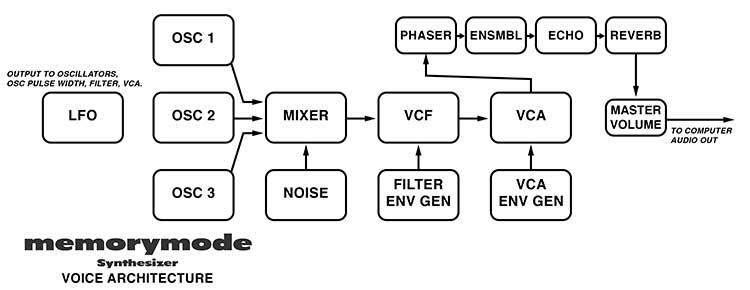
Memorymode's overall layout should be familiar to anyone experienced with classic mono and poly synths. The signal path begins in the center of the instrument with three almost-identical voltage-controlled oscillators, each with selectable range and ramp, triangle, and pulse waveforms; the pulse includes a pulse-width control. Oscillator 1 includes a Sync 2 to 1 button, and oscillators 2 and 3 add Frequency fine-tune controls. Oscillator 3 also includes a sub-audio Low range button and Keyboard Control button for disconnecting the normalled keyboard control voltage; both of these are intended for using Oscillator 3 as a modulation source. The three oscillators are routed to independent level controls in the mixer section. The mixer also includes a noise level control.
The summed mixer signal travels to the Voltage Controlled Filter (VCF), which affects the sound timbre. From the VCF, the signal travels to the Voltage Controlled Amplifier (VCA) for amplitude shaping via the VCA ADSR envelope generator. The VCF also has its own ADSR envelope generator for dynamic filter tone shaping.
The signal then travels through the onboard Phaser, Ensemble, Echo, and Reverb effects, and to the Master Volume knob and output.
Memorymode also includes two independent modulation sections - LFO Modulation and Voice Modulation. These are fully explained in the Modulation section, but the basic difference is that LFO modulation is monophonic; that is, a single standalone low-frequency oscillator is equally applied to all voices, whereas Voice Modulation individually modulates each voice using oscillator 3 and/or the filter envelope generator of that voice. Each method is appropriate for different uses (with some crossover).